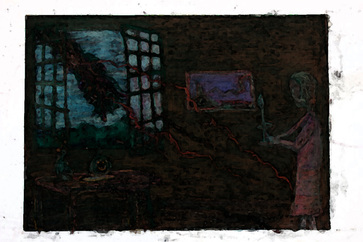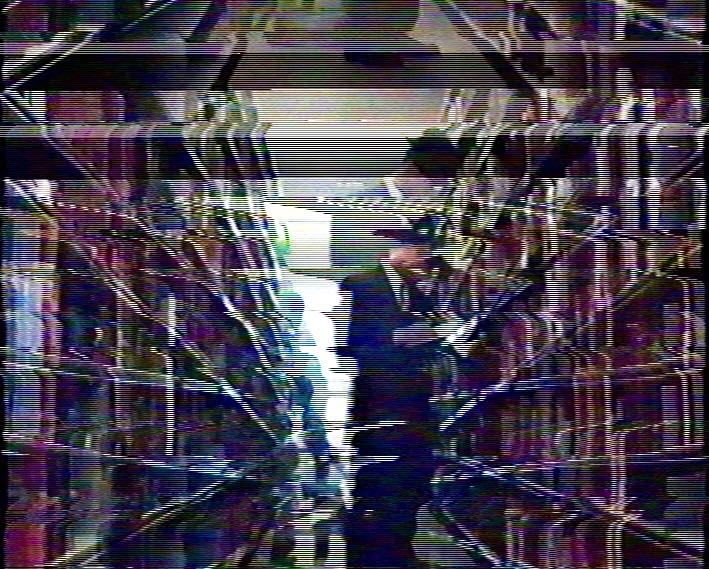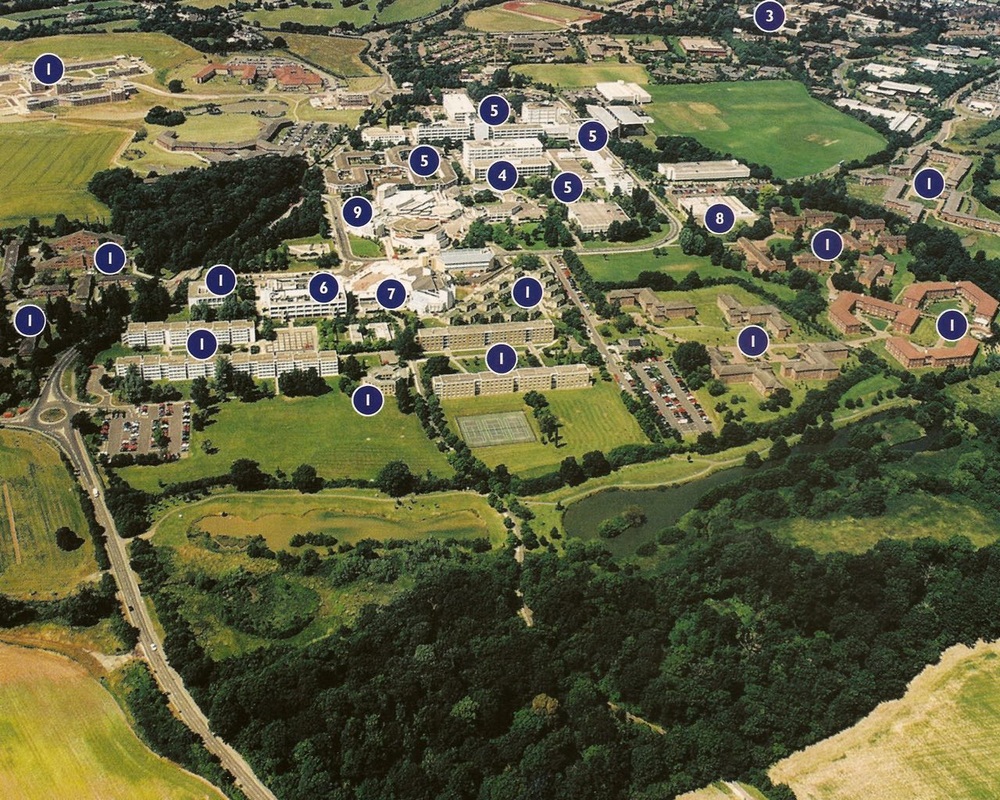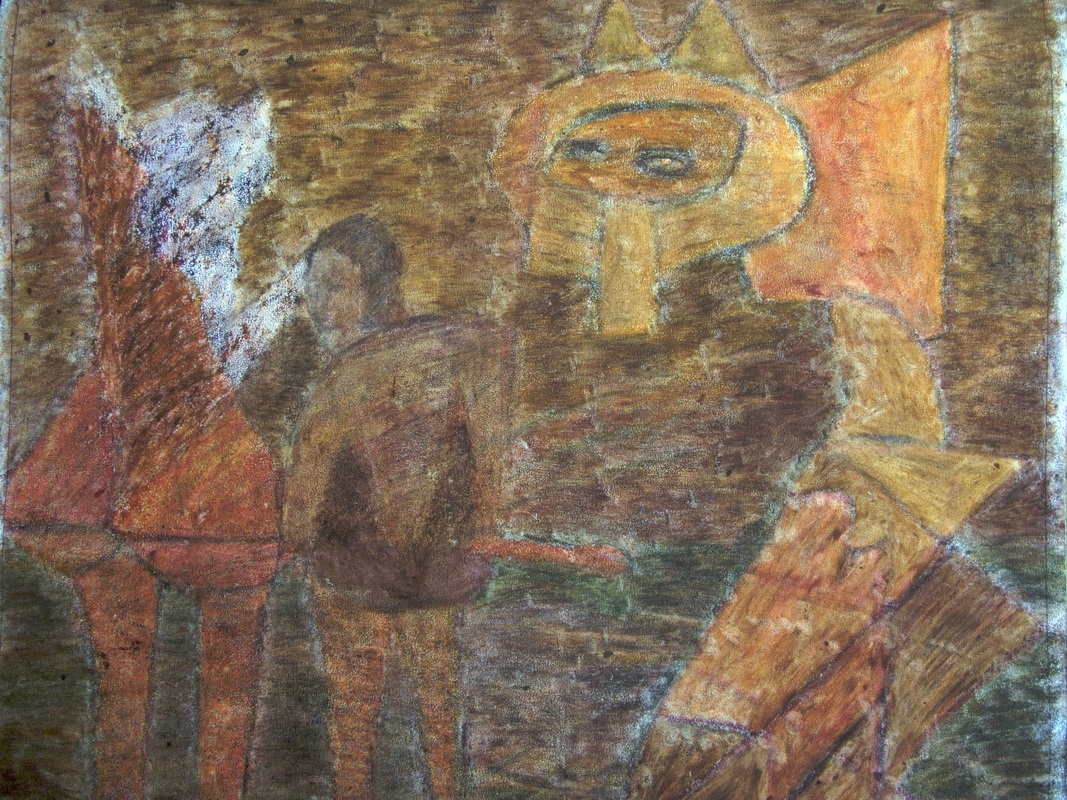|
A film can haunt you in many different ways. In 1978, an excited boy and his overworked parents trek down to the Odeon, Leicester Square. No, not the previous summer-smash Star Wars, but it's more domesticated twin, Close Encounters. Inspired by The Third Kind, he would travel home counting every twinkling light of air traffic as an alien ship passing in the night sky. A fifteen year old is skipping across the ground level section of Westway (A40) and bunking into an X-rated double bill of Terror and Savage Weekend. It's 1981 and the last gasp of the ABC cinema at Edgware Road. Young men are performing a ritual of daring each other to grin through slit throats and dismembered heads. Jump cut. That boy-teen-man is now projecting a 35mm print of Peeping Tom to sleepy film and literature students at the University of Warwick. He is anxiously waiting for cue dots to appear. After effecting a change of reel, seated alone beside a small aperture in the booth, he looks out across the illuminated heads, several bobbing down to new planes of consciousness. The projectionist is transfixed by the imagery on the screen showing a movie camera that has been turned into a deadly weapon. Yes. Those are all my hauntings and they still persist to haunt. This year of slow motion into middle age has lead to a reappraisal of the Italian director, Mario Bava. His richly lensed films were discovered online where there are collective opportunities for the young and old alike to be haunted or re-haunted. This past year has seen the passing of the great Christopher Lee. I kept YouTubing majestic scenes from Bava's The Whip and the Body. In particular, there is a compelling sequence when the heroine is being drawn to the S&M ghost of Lee down a darkened corridor by the constant cracking of a whip. Cinematic magic. As a practising multi-media artist this "haunted" quality only manifests itself in drawings and unpublished or unrealised screenplays. I share a few of the former with you. Although my lips are temporarily sealed on the latter, I do wish to share a few thoughts about a seasonal haunting, Quatermass and the Pit (1967). QM is a great British science-fiction film, bristling with bold ideas and told in a vivid fashion. The electronic sound effects by Tristram Cary, combined with effective direction by Roy Ward Baker and compelling performances, makes this a haunting of hauntings. The film is also part of the rich cultural tapestry of Hammer studios before that fizzled out in the 1970s. An older generation would have experienced the Nigel Kneale's Quatermass stories (of which Pit is the third in the series) when broadcast by the BBC in the 1950s. These are rightly regarded as landmark moments in British television. Enthusiasm aside, I want to talk about the haunting engendered by Quatermass and the Pit. This has a very specific past, present and future. Past tense. I have a ghostly memory which can be precisely dated to Christmas Day, 1973. This turbulent period in British politics would see industrial disputes, three day working weeks, power cuts, and a country grinding to a halt. I can still feel the bones of those darkened and cold spaces. This was the perfect setting for an impressionable seven year old to be spooked on Christmas Day when Quatermass and the Pit was shown as the main late night adult film on BBC2. I seem to recall watching this film alone. Where had my family disappeared to? Had they been swallowed up by the gut of seasonal excess? It matters not, for the film exerted a pulsating grip especially in its claustrophobic evocation of the London underground where a mysterious object is discovered and which unleases atavistic impulses in the human mind. Present tense. As a homage to that 1973 haunting, I decided to photograph a recent transmission of Quatermass which took place on 20tht December 2015. Towards the end of the film, the television underwent a spectrum change with its cathode ray tube. The green light waves completely swamped the reds and blues. I am still trying to interpret the significance of this haunting and I present documentary evidence for your perusal. The TV box on the following Boxing day was as right as rain. Future tense. Quatermass and the Pit is older than Time Lords and Jedi knights. It is begging for a new leash of life and I wonder if the current Hammer Films might be thinking about a re-make. If they do, they will be hard pressed to beat the original TV and film adaptions. Special effects will be a different kettle of fish however. Hopefully a new generation of writers and film makers will discovery the original and use it as source material to create their own narratives. I've just started mapping out a new screenplay called Glass Kill in which medi-EVIL stained glass is discovered in the London underground. Hauntings can come in all manner of tea cups or flying saucers and is not exclusive to the horror genre. If you want to catch a fascinating blast of gallery based hauntings, I point you no further than the sublime Susan Hiller who is showing at the Lisson Gallery until the 9th January. She has described her work as an "archaeological investigation, uncovering something to make a different sense of it." Here you will find an eclectic probing into the real and the unreal, the memory of ghosts and the ghost of memories. Of particular interest is Wild Talents (1997). This is a multi screen video installation that shows paranormal phenomena in a range of American and European horror films and this is juxtaposed with a small monitor showing a documentary about children who have religious visions. Three sets of images are unfolding in the same time and space. Haunting is all about the co-existance of past, present and future. Quatermass and the Pit airs next on the Horror Channel on: Thursday 31st December @ 22:55 Saturday 23rd January @ 22:00 Wednesday 27th January @ 22:00
0 Comments
For the past few months, I've been re-mastering This-That in close collaboration with the film's author, Jacob Barua, who lives in Kenya. To recap, This-That was made in 1989 when we were both third year Film and Literature students at the University of Warwick. It is a fictional drama about an alienated student who finds transcendence in a stone figurine. It was my first involvement in a film project and a great all round experience on the acting, editing and production front. The film was screened twice at the university in 89 but was shown more as a rough cut. We had not devoted enough time (days rather than months) for the edit process and a key animation sequence, shot by a security guard on 8mm film, could only be included after the end credits for the second screening. The film was seen by about 100 people on a 10,000 plus student campus. As there was very little feedback, we always assumed it left those select few stunned in a cinematic stupor. It received more rigorous scrutiny when projected at Lodz film school where Jacob subsequently enrolled. One Prof likened it to a visual tone poem in the style of T.S. Eliot's Waste Land. It has taken us a full 26 years and the occasion of the 50th anniversary celebrations at the University of Warwick to do justice to a film that gave "students and classics a bad name" according to one apocryphal review. The master VHS tapes were stored in the perfect micro-climate of Nairobi. Natural deterioration of the magnetic tape has resulted in some contrast loss and discolouration, especially noticeable in shots of the sky. Jacob attempted the first digital transfer at a Kenyan edit suite but the DVD files he sent me were poor. The tapes were then couriered over and I had a Kodak lab transfer them into AVI digital files or such was the theory. Despite several efforts, this lab could not perform a professional service and the files either had an interference signal or no sound, and even more lamentably, were unable to open up in Mac as Kodak were using Windows based systems. Refund time. Third time lucky and another lab was able to get a clean digital transfer from the VHS. They also cropped in slightly to remove the flickering decay at the edges of the 720x576 video resolution format. While we may have attained a state of grace with the imagery, the sound track is still a work in progress. There are plans to completely re-score the film and this will hopefully be accomplished next year, perhaps as a commission for a young music student or budding composer at the University of Warwick. I believe the film holds up incredibly well and this is testimony to the mystical cinematic talent of Jacob. The biggest challenge however were the labyrinthine sequences shot at the student union and fancy dress ball. This rightly gets the scissors treatment and is now more tightly interwoven with the preceding and concluding scenes of dream and spiritual release. Both Jacob and I wondered whether Him (the name of my character) should speak in the new version; we could have added an interior monologue. Sensibly we have stuck to the original conception and have maintained a quality of enigmatic silence. I only utter one "rosebud" word in the film. This-That is very personal and akin to watching myself through a looking glass. There is some loss of light transmission (not digitally induced) but it is strangely reassuring to see a twenty-six year younger version of your self. I am dressed throughout in 1940s suits and trilby; that was my fashion throughout the 1980s and 90s. I was and still am haunted by Greek mythology (it is in my cultural DNA after all) and this is offset by events on the political stage. Those events of 1989 involved the collapse of communist walls and the abortive student-lead Democracy Movement in China. How did the young of that world react to their elders? In the film, we have an off-key portrait of a student, a budding writer who is literally lost for words. For him there is no solidarity with peers or the possibility of creative action, whether individual or collective. The figurine he reaches out to grasp contains some unknown or primal connection to a past-present-future. If there is a message at the close of the film (no spoiler alerts here), perhaps it is that our everyday actions and infrequent visions do not need to be held in temporal check by a freeze frame or fade out. We can edit and we should direct our own lives. I sincerely hope there are not too many alienated students amongst the current generation at Warwick that numbers in excess of 25,000. How many of them will be experiencing This-That? This-That will be screened in Spring 2016 at its spiritual home. Event details. Digital restoration has been supported by a grant from the Centre for International Theatre Development. This-Trailer trailer.
With my eyes closed, I sense her presence and hear a faint murmur, a sound that cascades into a tune.
This is an overdubbed improvisation in memory of Marie Henderson. A footnote in British theatre history, but in her time (1860-1880) and place (Royal Colosseum, Britannia and Elephant and Castle Theatres) she was a potent force in the world of melodrama. This orchestration celebrates the public and private life of Marie Henderson. The first section evokes the power of her performance in the smash hit of 1863: Faith, Hope and Charity. Marie plays Faith, a young clerical widow, cheated out of a property lease and who dies of a broken heart. She returns to haunt the treacherous aristocrat. He repeatedly stabs her image, but as with all good ghosts, she cannot be vanquished. This production employed the latest technological craze of the Victorian stage - Professor Pepper's optical illusion for stage ghosts. Glockenspiel and bells strike notes of tension or release, delicate or harsh surfaces that play off harp, French horn, strings and clarinet. For the finale, we find Marie Henderson in 1882 acting out her death. The actress had contracted syphillis (undiagnosed at the time) and ended her days in Bedlam Hospital with her husband by her side. An electric guitar sets the otherworldly tempo and is a poignant farewell to a theatrical force that had once captured the imagination of Liverpool and London theatre goers. I feel a tremendous affinity with the psychological soundscapes of Nordic music. Reference points for this composition are Sibelius 5th symphony and ECM Records Terje Rypal's Avskjed. Detailed blog entry on Marie Henderson.
There are great double acts in film direction and musical scoring: Hitchcock-Herrmann, Fellini-Rota, Leone-Morricone. It is often hard to imagine the image without the music and vice-versa.
You can throw Roman Polanski and Krzysztof Komeda into that mix. KK was one of the most important jazz musicians to have worked in film. In his short life, he scored 38 films from 1958-1969, most noticeably his collaboration with Polanski: Knife In The water, Cul-de-sac, Fearless Vampire Killers and Rosemary's Baby. How to describe his qualities? The uniqueness of his Polish slavic influences, married with the post-war developments in jazz (most noticeably improvisation, John Coltrane) and the ability to distil this in a bold, fresh manner for the cinematic frame. I really like the symbiotic relationship between his jazz and film music. The 1964 album Astigmatic, announced a cool, more abstract approach and can be seen as a forerunner of the ECM sound of Manfred Eicher. It's a pity there is no English-language book about Komeda. My old Professor at film school, Richard Dyer, has recently penned the definitive book on Nino Rota and hopefully someone will take up the challenge of putting Komeda's life and music into words. As a visual artist, I've created 4 drawings as a homage to his work. They have been improvised with the music as a backdrop. I'm responding to the emotional and psychological qualities of sound and re-imagining this as a filmic image. Homage to Svantetic is a pictorial reference to the mysterious death of Komeda in 1969 at the age of 37. He was involved in an accident in the States, possibly as a result of high-jinks with a compatriot. Not being insured, Komeda who had originally trained as a medic, travelled back to Poland for treatment and died shortly after from a haematoma. More information: Official Homepage of Krzysztof Komeda Virtual Museum of Krzysztof Komeda
At Latymer Mapping projects on saturday, artist Sandra Crisp showed us her film, Subterranean Rivers of London. Intriguing use of Maya software to envisage our long lost rivers as some type of essential, but dormant bodily process. Never has fluid mechanics seemed so appealing.
It is currently a silent film. Sandra will however use this screening as the basis to record a soundtrack for the film, probably mixing music with our voices. Those present during the screening were asked to meditate on the film and then provide some sort of feedback or description. A microphone recorded their responses and here is a sample. Alistair: a detailed description for an imaginary soundtrack, complete with violins in the mode of Bernard Hermann's shower score. Judith: River, brook, stream, creek, rivulet. Rivulet, creek, stream, brook, river. Allan: the graphics induced a feeling of interconnections, spider-webs reaching out and in. I created a spontaneous tone poem: words and ideas to match the rhythm of the images. Looking forward to seeing how Sandra sculpts our words into the mix for her Subterranean Rivers of London. |
Categories
All
Archives
May 2024
|
























 RSS Feed
RSS Feed
